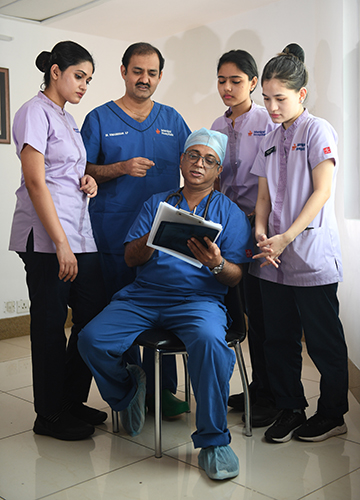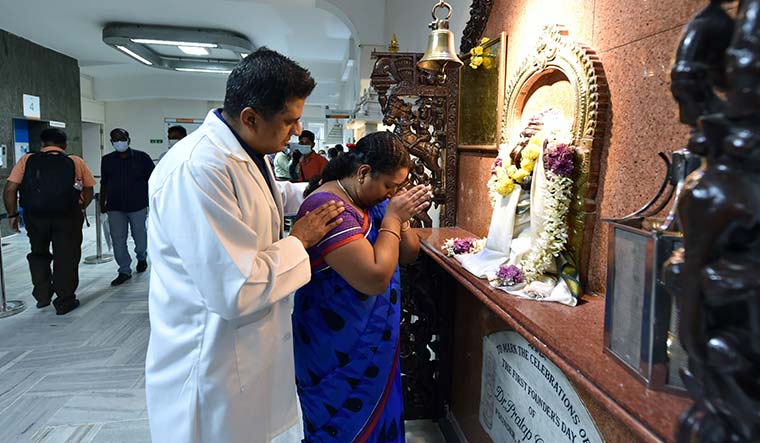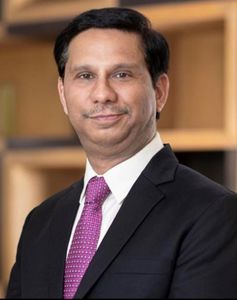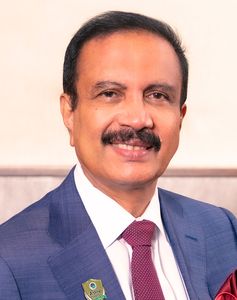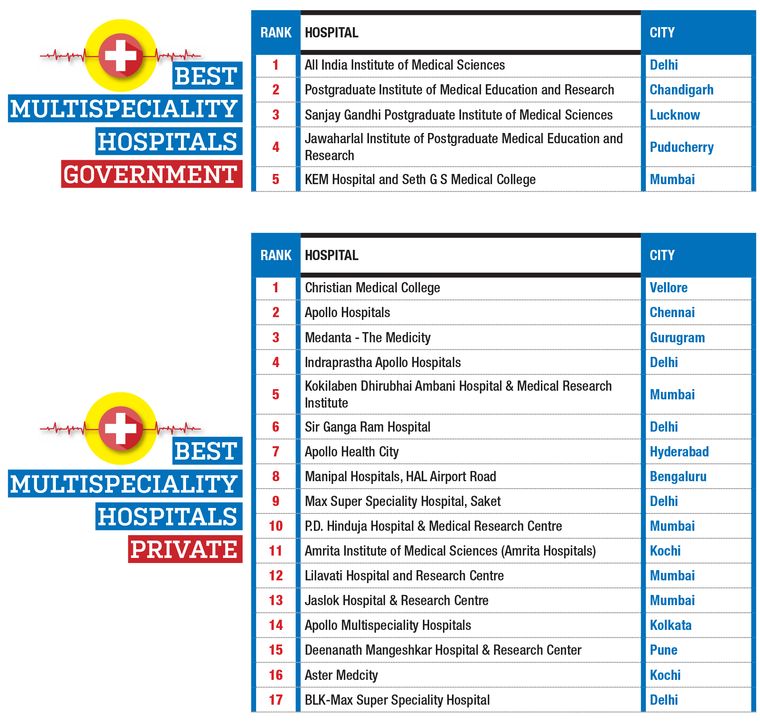Over the past two years, two significant aspects which led to a “paradigm shift” at the Fortis Healthcare, Bengaluru, have been “technology adoption and hand hygiene,” says the hospital’s vice president Manish Mattoo. “Doctors who used technology were just 5 per cent before the pandemic, whereas that number is 70 to 80 per cent now. Video consultations have gone up from 10 per cent to 35 per cent. At the same time, the Covid infection rate in our hospitals has been zero for six straight months.”
At Mumbai’s Kokilaben Dhirubhai Ambani hospital, CEO Santosh Shetty recalls how the tough times of Covid-19 reinforced the culture of empathy among his clinical staff. “I will not forget the case of a 70-year-old mother and her 30-something daughter who were both infected,” says Shetty. “They did not have any relatives. Our staff took the daughter from the ward to the ICU so that she could spend some time with her mother. The mother passed away a few days later. It was a touching moment and the staff learnt lessons in empathy like never before.”
In the face of the unprecedented health care crisis caused by Covid-19, hospitals across India faced multiple challenges of access, safety, supply chain logistics and financial stress. It resulted in huge patient loads and fatalities, heavy financial losses and a sharp decline in revenues. Elective procedures were cancelled or postponed to prioritise hospital capacity, while patients limited hospital visits because of concerns about potential exposure to infections. Many of them died from the lack of care for non-Covid diseases. There were layoffs, furloughs and salary cuts to contain costs and maintain financial viability. The second wave led to an even bigger mayhem.
Hospitals have learnt their lessons from the pandemic and have started implementing policies which could redefine the way health care is managed and patients are cared for. For instance, universal masking and hand washing have been institutionalised. Flexible design and an air-conditioned environment have become critical requirements for future hospitals. Screening of patients and staff on a regular basis to minimise the risk of cross-contamination has become a priority.
“The next normal for health care will look nothing like the normal we leave behind. Until recently, the focus has been on lifestyle diseases such as cancer, cardiovascular diseases, diabetes and obesity. Significant investments have been made in both public and private sector to reduce morbidity and mortality from these non-communicable diseases. But the pandemic highlighted the need to have a renewed focus on infectious diseases as the next pandemic from a new infectious disease source may be round the corner,” says Shetty.
When Covid first struck, most hospitals were hardly equipped to deal with the crisis and had to think about innovative methods to tackle it.
“On March 12, 2020, when we had our first case we had no infrastructure for handling Covid-19. So I took the decision to send the patients to a separate building,” said Gautam Khanna, CEO, P.D. Hinduja hospital, Mumbai. “For Covid patients who were isolated at home, we introduced the ‘Covid Care at Home’ package, which included video consultation with doctors, a nurse who would monitor the vitals every eight hours, a psychological counsellor and a dietician.”
Also, as hospitals re-evaluated their delivery mechanisms, patient expectations regarding their safety changed dramatically, says Dr K. Hariprasad, president, Apollo Hospitals. “Nowadays, patients respond to options that address their individual needs like quick access to medical records and technology-enabled, educational and medical services which allow them to participate in their own care process. Patients expect diagnostic procedures and treatment paths to be personalised as per their requirements to integrate their preferences and needs,” he says.
A digitally enabled India helped hospitals across the country to introduce policies, processes and systems which have redefined both health care delivery and patient experience. Some of the processes which hospitals added during the pandemic to safeguard patients and employees have turned into long-term policy changes. Digitisation of processes is one such thing. This includes paperless registration, online screening, thermal screening at hospital entrances, bedside admission and discharge billing, faster discharges, multi-skilling of staff and the use of speech-to-text technology. This kind of digitisation, says Dr Hariprasad, has helped in making processes simpler and more accessible for patients.
INFRASTRUCTURE UPGRADE
The shortage of beds and advanced equipment during the pandemic has established the need for a health care system that is ‘emergency-proof’. Accordingly, hospital chains and speciality centres are coming forward to build more facilities, especially in tier-II and tier-III cities. “Numerous hospital chains have started expanding in these cities by setting up small clinics and by associating with reputed local doctors. This is also aligned with the government’s efforts to increase the number of hospital beds per thousand population and close the accessibility gap, mainly in the suburban and rural parts of the country,” says Lalit Mistry, director, healthcare, KPMG India. Oxygen storage capacities, too, have been improved, to avoid a repetition of the crisis seen earlier this year.
Rainbow Children’s Hospitals, for instance, has increased the availability and storage capacity of oxygen at all its units. Dr Ramesh Kancharla, CMD, says, “We have increased the number of paediatric ICU beds. We converted around 600 of 1,500 beds to ICU beds during the pandemic. We have arranged the necessary equipment, monitoring devices and ventilators. The stock of medicines needed to treat Covid-19 positive children is well maintained. The total number of beds in the paediatric intensive care unit and the neonatal intensive care unit at our hospital is around 200 and 300, respectively.”
Hospitals have undertaken process innovation at multiple levels, such as developing apps for virtual consultation and quick access to health information. Apollo has developed online self-screening for Covid-19 infection before a patient walks in. Other innovations include paperless self-registration by patients at kiosks at the hospital entrance, online diagnostics and lab reports that go directly to the patient’s registered mobile phone, and paperless bills sent to patients’ and attendants’ registered mobile phones. Digitisation of processes has also helped in reducing the turnaround time for both clinicians and patients. Several hospitals also undertook efforts to multi-skill their staff, including non-clinical workers, through virtual calls and training on Covid-19 protocols.
Max Healthcare Institute Limited (MHIL) ramped up its home-care services for chronically ill patients. “We offer 17 lines of services including nursing, physiotherapy, pathology and critical care at home, along with delivery of medicines. The key learning was that this service can continue to add value to patients,” says Dr Sandeep Budhiraja, group medical director, MHIL. The institute also set up oxygen plants at seven hospitals to augment critical oxygen supplies and serve as a back-up for potential disruptions.
The implementation of electronic medical record system and lab information system has helped Aster DM Healthcare ensure that patient data is readily available for doctors on the go and patients are able to access their lab results from home. “We have also implemented PACS (picture archiving and communication system) which makes the archiving and sharing of radiological images easy, helping in diagnosis and treatment,” says Dr Azad Moopen, founder chairman and managing director, Aster DM Healthcare. All 27 hospitals of the group, located in seven countries, are now connected via virtual platforms which expedite interactions, save time and help avoid travel expenses.
At Apollo, regular processes like bedside admission and discharge billing have been overhauled in such a manner that patients no longer have to wait for paperwork. To eliminate waiting time and crowding, Apollo has initiated bedside admission and discharge billing process for all planned admissions. “After reaching the hospital, the patient can directly move to the assigned room without waiting at the admission counter. This eliminates waiting time, keeps the patient and family away from public area and enables the initiation of care as soon as the patient arrives,” says Hariprasad.
During the pandemic, most hospitals restricted their visiting policies, which left families unable to meet their dear ones in hospital and also get direct updates from the clinical team. Many hospitals have developed patient centric communication apps to resolve the crisis. These apps can be downloaded on to personal devices. In the case of Apollo, whenever a patient is admitted, a link with all the relevant details is shared with the family on a designated mobile number. It also has a video call facility. Going forward, the hospital aims to share post-discharge instructions through the app, so that the patient and the family are informed about the care and precautions to be taken.
Additional measures have been undertaken in the fields of infection control and prevention, too, to make sure the chances of infection are minimal. “Our hospital has HEPA filters and special air handling units for maintaining bacteria-free air circulation. We have the latest generation multi-channel cardiac monitors, intracranial pressure monitoring equipment, in-house 2D echo, continuous EEG monitoring, ultrasound machines and haemodialysis machines,” says Dr Kancharla. “The paediatric ICUs are equipped with the latest generation ventilators, nitric oxide delivery units and high frequency oscillators.”
Some hospitals like Apollo seal their cleaned rooms with a ‘clean-seal’ sticker to ensure that no one enters it before admitting a new patient. They also have a ‘green corridor’ to transport suspected and confirmed Covid-19 patients. Such features are likely to be continued in the long-term.
TELEMEDICINE: EXPANDING ACCESS
Given the significant advantage of near-zero contagion risk, telemedicine has emerged in a big way and experts foresee its “exponential growth” in post-pandemic India. According to experts, the domestic telemedicine market will reach $5.5 billion by 2025. Additionally, the telemedicine practice guidelines published by the government last year have led the country to transform from a provider-centric volume-based model to a patient-centric value-based one. “Indian health care providers have used technology in a big way during the pandemic to connect with their patients. With the help of telemedicine and e-ICUs, they remotely delivered quality health care to patients in smaller towns, and even in villages. There has been a shift towards daycare treatments which reduce the chances of getting exposed to Covid-19. Such interventions can reduce the cost of health care in the long run,” says Bidhan Chowdhury, CEO, Medi Q Healthcare Group, a global health care consultancy. Agrees Dr Moopen, whose hospitals offer telemedicine facility to all patients. “We now have the technology and the personnel to provide remote ICU monitoring. It helps utilise the services of intensivists in many hospitals who deliver real-time information,” says Dr Moopen. The government rolled out the Pradhan Mantri Digital Health Mission to make telemedicine a legal practice in the Indian health care market, which is expected to reach $372 billion by 2022, says Karthik Rajagopal, COO, Manipal Health Enterprises. “It aims at increasing health care spending to 2.5 per cent of the GDP by 2025.” At Manipal hospitals, nearly 25 per cent outpatient services had moved to telemedicine during the peak of the pandemic. The figure now is 8 per cent, says Rajagopal.
INTERNET OF THINGS
Internet of Things (IoT) has the potential to revolutionise the delivery of medical treatment and improve health indices. This is a system of connected computing devices or machines in real time, each having the ability to share data with other devices without the need for human or computer interaction. IoT, say experts, can help doctors and patients benefit from the ‘automated, asynchronous medical data flow when treating chronic diseases and critical health issues’. IoT will be most beneficial for those suffering from chronic illnesses and require continual monitoring, and those from rural locations with limited access to medical care. It allows the uninterrupted collection of live data, which helps in making more informed diagnoses. This is also called precision medicine, as it involves developing treatments unique to each patient, based on diverse health indicators. It allows continuous remote monitoring of non-critical patients at home, thereby reducing the need for in-person consultations and lowering the unnecessary cost of chronic care. An example of how seamlessly the IoT works is the programmed insulin pump, a wireless continuous glucose monitor (CGM) that the patient must wear at all times. The CGM has a sensor that collects live or near-live blood glucose and other sugar-related data even when the person is sleeping. This method eliminates the need for finger-prick tests, making it extremely easy for patients. When the values fall below adequate thresholds, the insulin pump kicks in.
Also read
- Best Hospitals Webinar, 2021: THE WEEK honours excellence in health care
- Dr Jame Abraham of Cleveland Clinic on when doctors feel vulnerable
- THE WEEK-Hansa Research Best Hospitals Survey 2021
- Nurses put the care in health care, more so during the pandemic
- Challenges of being a male nurse
- Artist Nilima Sheikh's 'Salam Chechi' is a tribute to nurses
Various hospitals had their clinical teams initiate multiple Covid-related research projects to study different facets of the disease, which will have a long-term impact on treatment protocols and clinical outcomes. MHIL, says Dr Budhiraja, has over 60 projects involving clinical trials and research. “The findings in the form of academic papers have been published in 130 national and international journals and have immensely added to our knowledge of Covid-19 and long Covid and its impact on the human body. Scientific publications of this nature will help us in the coming years.”
Yet, experts suggest that health care providers should vastly scale up the number of beds, while cutting the cost per bed. They should opt for scientific cost-management systems using artificial intelligence-based data analytics. Chowdhury says the Ayushman Bharat scheme of the Union government will help millions access affordable quality health care. Agrees Mistry, who says schemes like Health for All, Ayushman Bharat and the National Digital Health Mission have, of late, grown exponentially. Such efforts by the government to make health care affordable and accessible for the entire population also offer scope for private players to widen their reach and presence.


